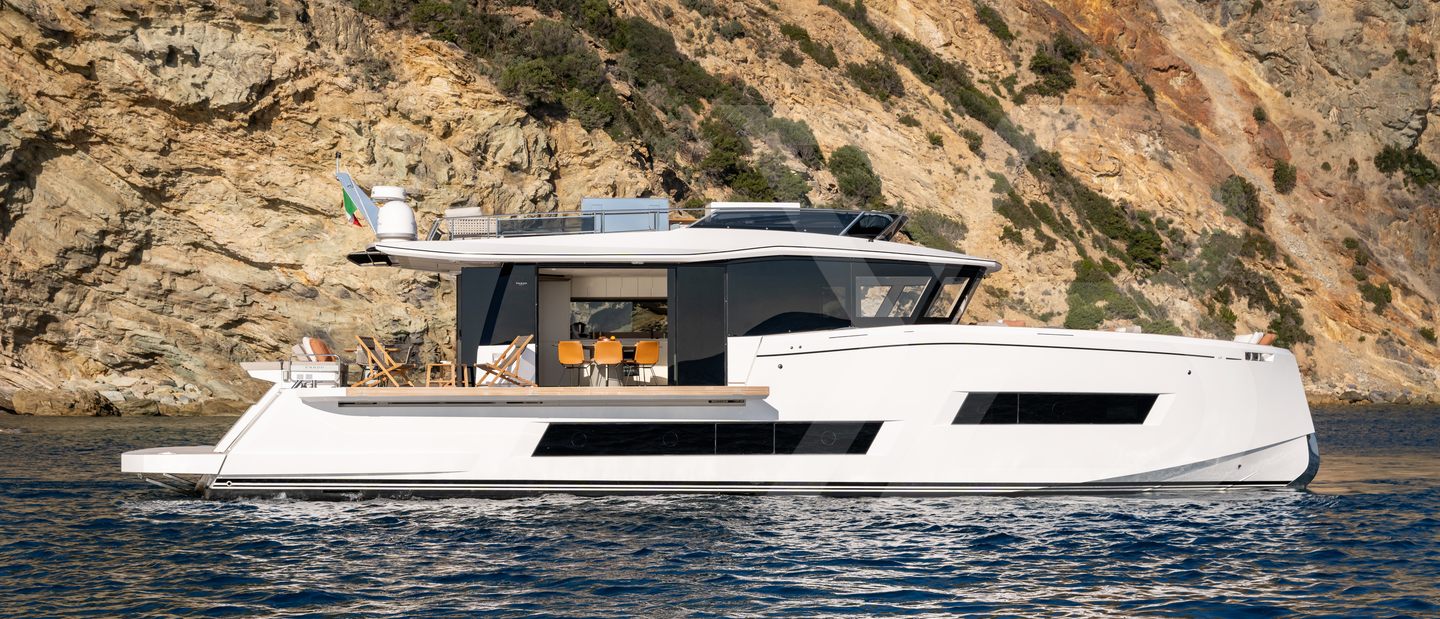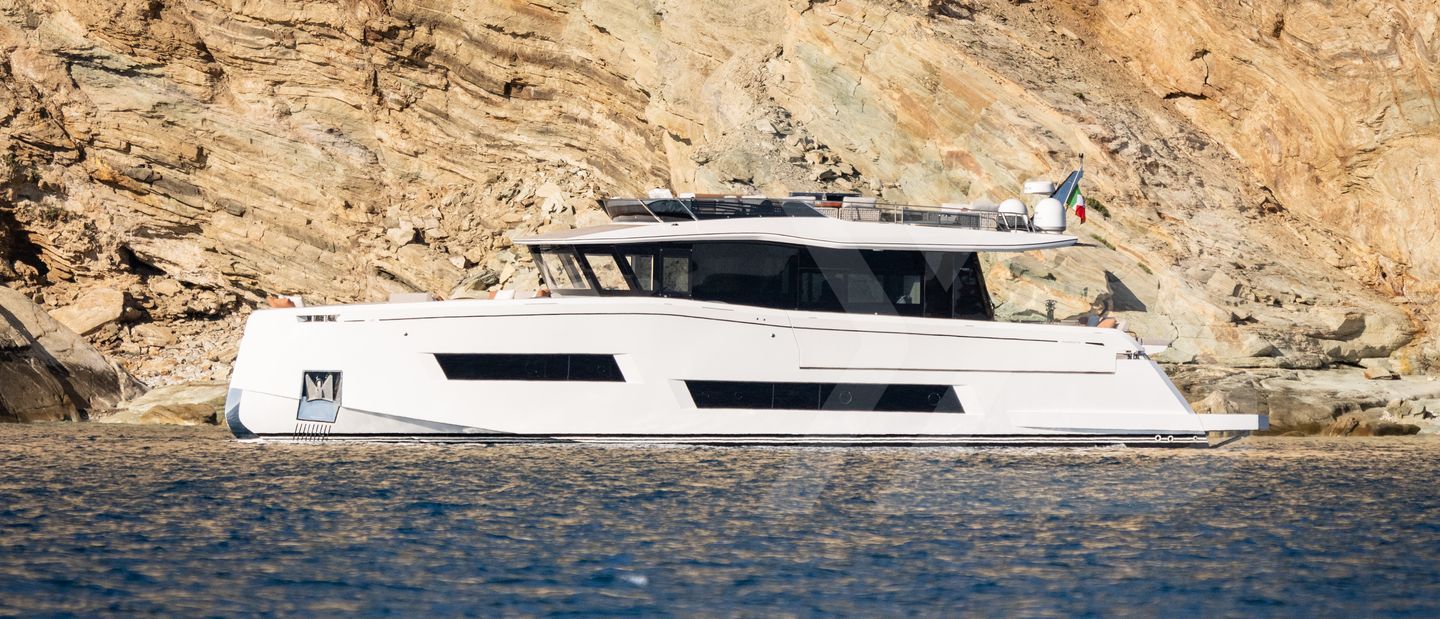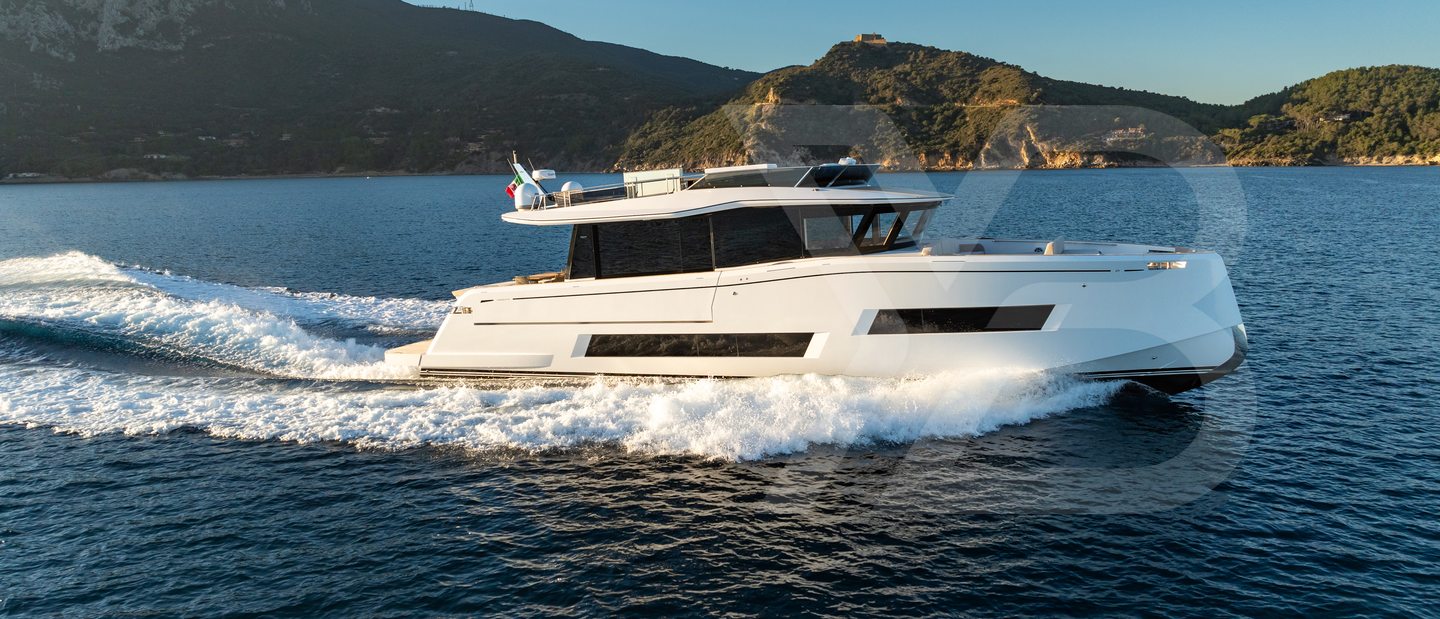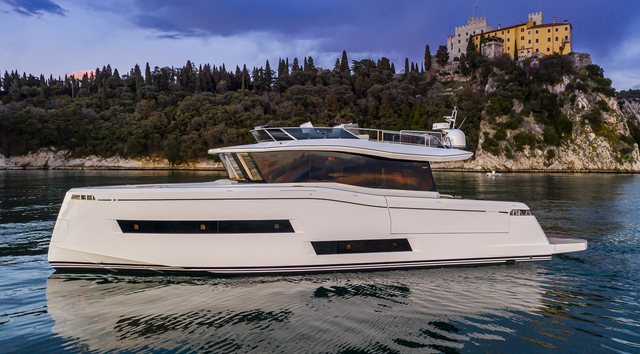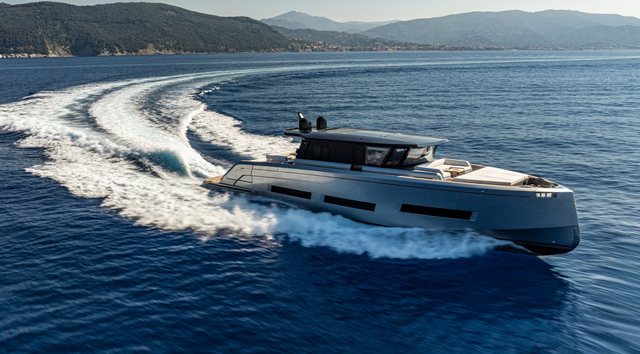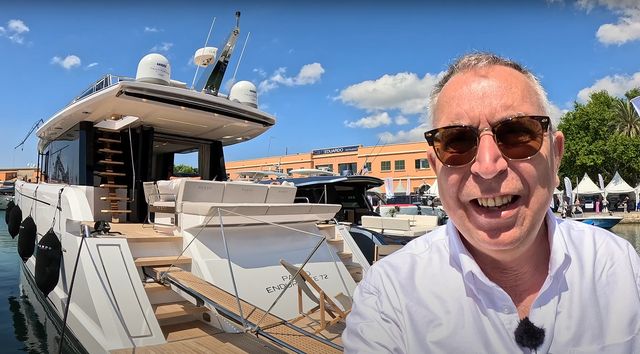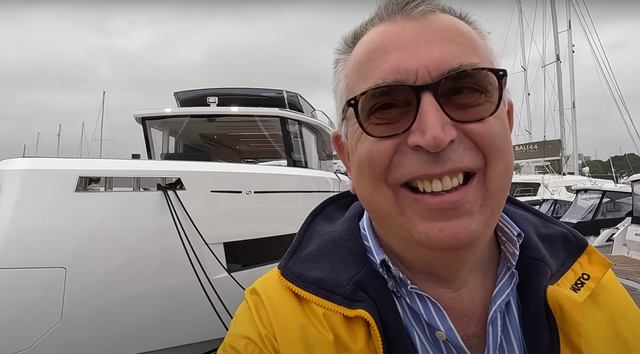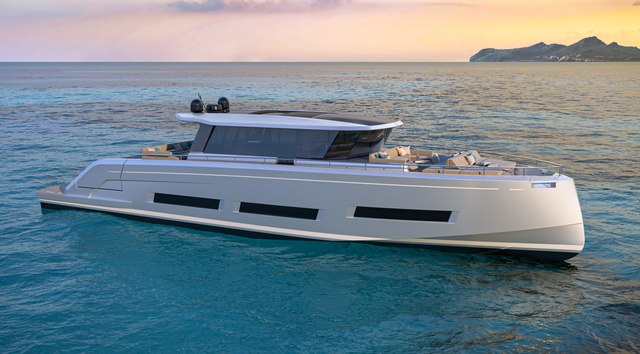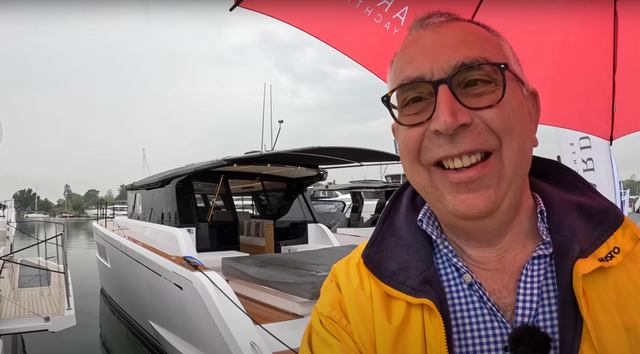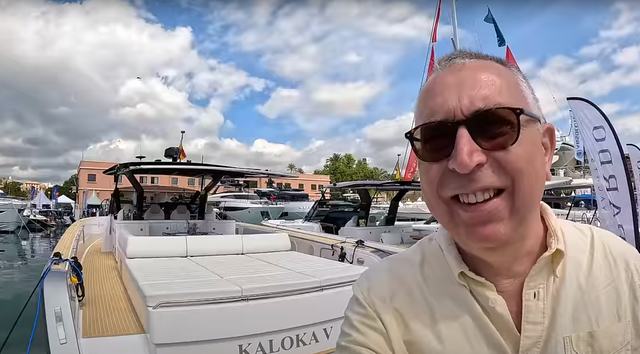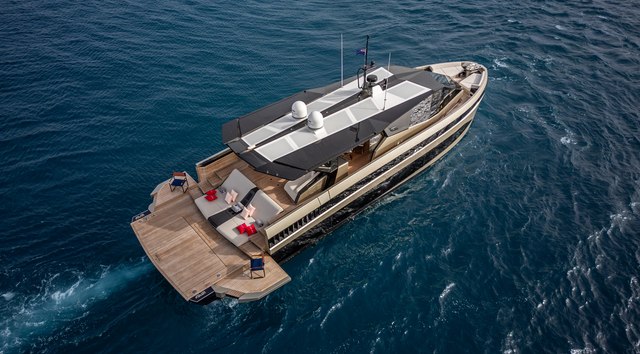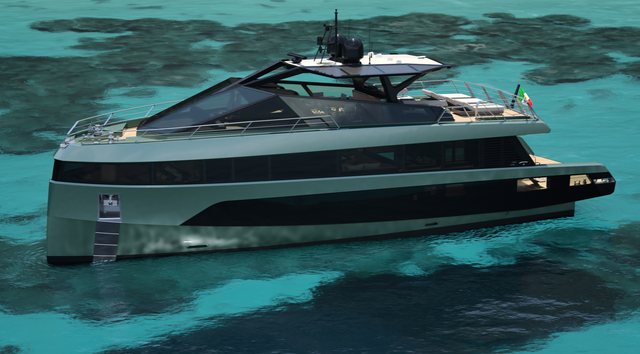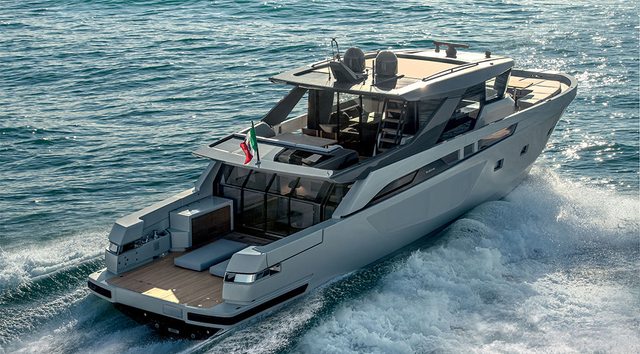We got to test drive the E72 in Mallorca out of Port Adriano and tour her at the Palm Beach Boat Show 2025, where she’s up against the Azimut Seadeck 7, Absolute Navetta 70, and Bluegame BG74.
With a tender garage that can swallow a 4-metre tender, vast drop-down terraces that link straight to the saloon through wide sliding doors, and a 3/4 cabin layout with private access to the full-beam owner’s suite. There’s a well-sized flybridge with space for a bimini or a carbon T-top, plus an upper helm where you can take charge of a pair of IPS1350s with 1,000hp each. The Endurance 72 sits at the top of Pardo’s slow cruising range - 22 metres long, 5.5 metres wide, and riding on IPS pods with a shallow 1.7-metre draft. It’s a 50-tonne displacement boat built to travel comfortably, so read on to find out how she drives.
Test & Review Video
Around the Marina
Berthing can be managed entirely on the joystick, with a Dynamic Positioning System so it’ll happily hold station if you need to pause, grab lines, or sort fenders. There's a third control station in the cockpit, but with clear sightlines from the main helm and the side door close at hand, working from there can feel like the natural choice. Bringing the E72 in port side to, the joystick lets you manoeuvre into a precise sideways slide to line up with the berth.
The bow thruster is there in case of any cross-wind, but IPS control offered sufficient precision throughout the entire manoeuvre. Cameras give a helpful additional view, particularly aft, but there’s something about physically sighting the gap yourself that’s always more reassuring.
Although we test many boats equipped with the same IPS engines, installations do differ, and there was a noticeable delay between the input from the joystick and the engines/pods responding. Not necessarily an issue, but it takes some getting used to.


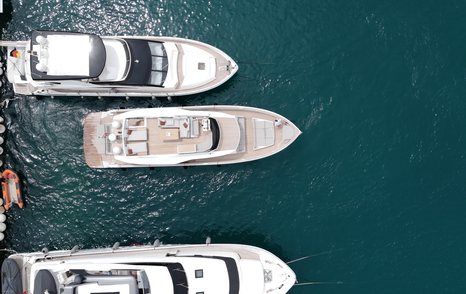
At Sea
Handling is as expected for this type of yacht - calm and steady. It’s not a hull that encourages tight, dynamic manoeuvres, nor is that the design brief. Pardo’s open models and GT line cover that ground. The E72 is designed to track straight and cover long distances with ease. During the trial, conditions were quite kind and offered no real challenge to the hull.
Even so, it slipped through the water with the settled, quiet progress typical of the Endurance range. The claimed top speed is 28 knots; we saw 26 knots on test. The ride is controlled, the movement smooth, and it carries speed with little fuss. The yacht is fitted with a gyro stabiliser - there are no fins - so stabilisation underway is limited, but the gyro offers support at anchor.



The Pardo Endurance 72 takes its place as the flagship of the Endurance range, a yacht with a relaxed cruising soul wrapped in crisp Italian lines. Naval architecture is the work of Davide Leone Yachts Design, delivering a hull that’s optimised for efficient semi-planing performance, while the shipyard’s in-house design team has carefully sculpted the exterior to carry Pardo’s unmistakable style.
Inside, the interior has been entrusted to BurdissoCapponi Yachts & Design, who have given the living spaces a clean, welcoming feel without tipping into minimalism. It’s a boat that feels solidly built, sharply drawn, and entirely geared towards enjoying time on the water.
Hull efficiency sits at the heart of the design. The E72’s fine bow entry and broad aft sections keep the ride smooth and help the boat slip through the water comfortably at its 12-knot eco-speed. Pod drives – twin Volvo Penta IPS 1350s with 1,000hp each – are neatly matched to this hull form, giving low-speed precision and helping to keep fuel consumption in check.
At cruising pace, the E72 will cover just shy of 1,000nm, and with 6,000 litres of fuel in the tanks, she has the range to roam. This is a yacht that isn’t built to chase speed – it’s designed to travel with comfort, efficiency, and enough flexibility to push into the mid-20s when needed.

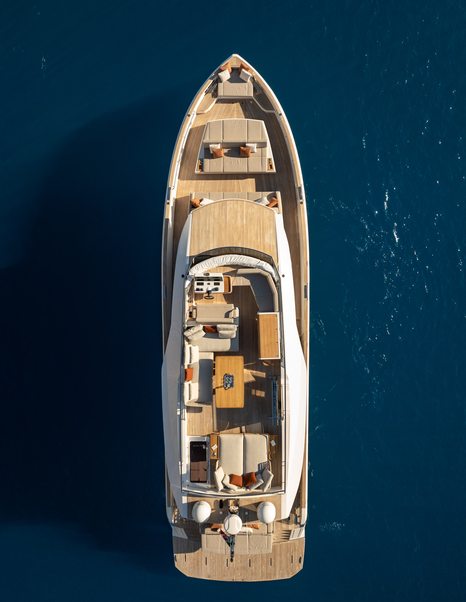
Where the E72 really earns its stripes is in deck design. The living spaces on board are seriously generous – the shipyard describes the deck areas as providing a "privileged relationship with the sea," and they’re not wrong.
Drop-down bulwarks on both sides transform the cockpit when at anchor, expanding the aft terrace to over 61sq/m (655 sq/ft) when combined with the hydraulic stern platform. It’s a lovely, open space that flows neatly from the main deck saloon, giving you options to relax on the aft sun pad, dine alfresco, or simply lean on the side terraces with a coffee and watch the water. The cockpit is all about flexibility – each space working just as well for socialising, relaxing, or waterside lounging.
There’s clever storage, too. The hydraulic garage at the stern can swallow a 4-metre tender, tucked neatly out of sight when not in use. The garage and platform system makes launching the tender a quick, crane-free process, practical, and likely to encourage owners to use the tender more often. Up top, the flybridge brings another 27 sq/m (290sq/ft) of living space to the table. It’s a vast deck with three sofas, a dining table, a wet bar option, and an extra-large sun pad at the bow. It comfortably extends the social and relaxation zones already provided on the main deck.
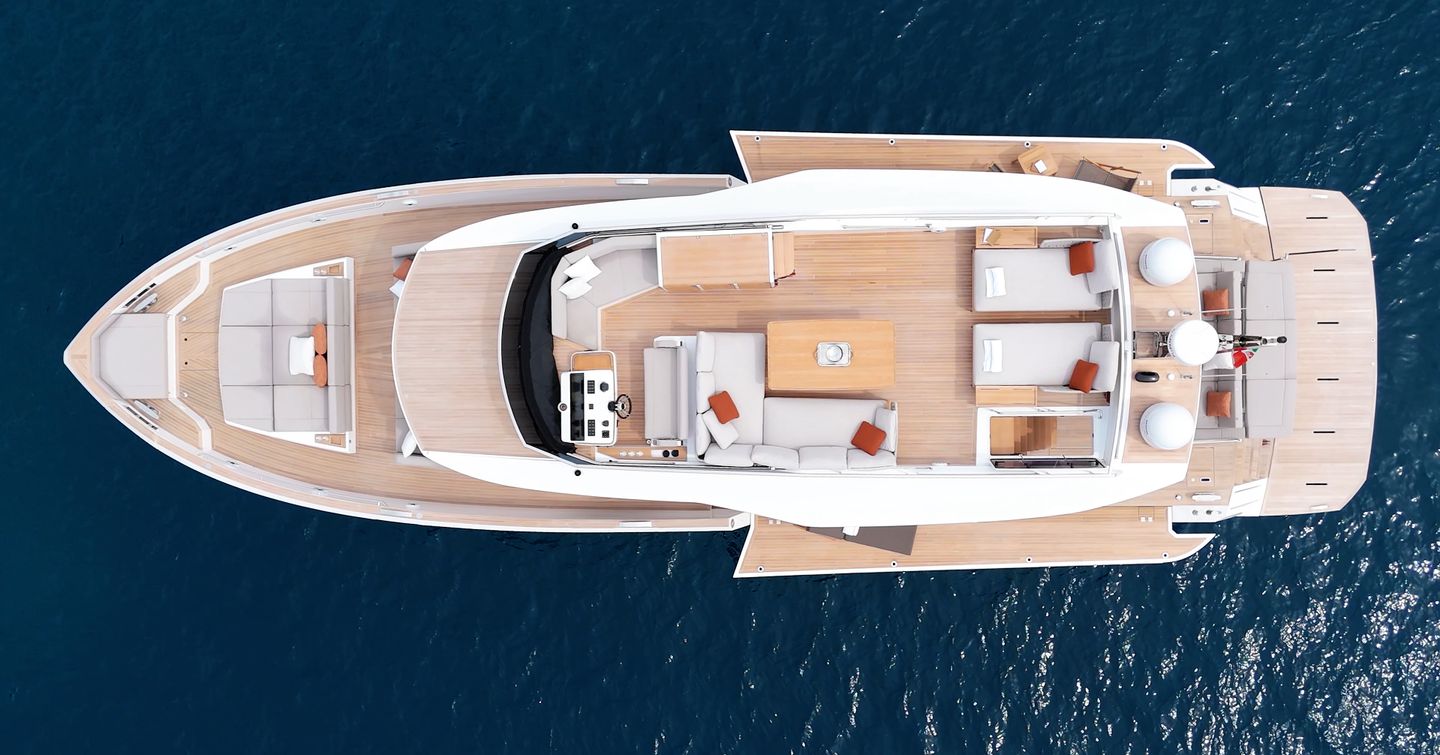
Options: Galley Up or Galley Down? T-Top or No-Top?
One of the most significant layout choices on the Endurance 72 is whether to go galley-up or galley-down. This decision shapes the rhythm of life on board and the feel of the entire main deck. The galley-up layout places the kitchen aft on the main deck, just inside the sliding cockpit doors. It’s a sociable setup - the galley is perfectly placed to serve both the interior dining table and the cockpit with minimal traversal around the boat. This arrangement keeps the conversation flowing, especially when the cockpit is expanded with the drop-down terraces.
For owner-operators or informal family cruising, this is a practical design as you can chat with guests while preparing food, keep an eye on everything, and no one is cut off from the action. With the galley up, you also get the maximum sleeping capacity: four guest cabins plus a separate crew cabin forward. It’s a setup that makes sense for owners who cruise with plenty of friends or family, or those who occasionally put the boat out for charter.
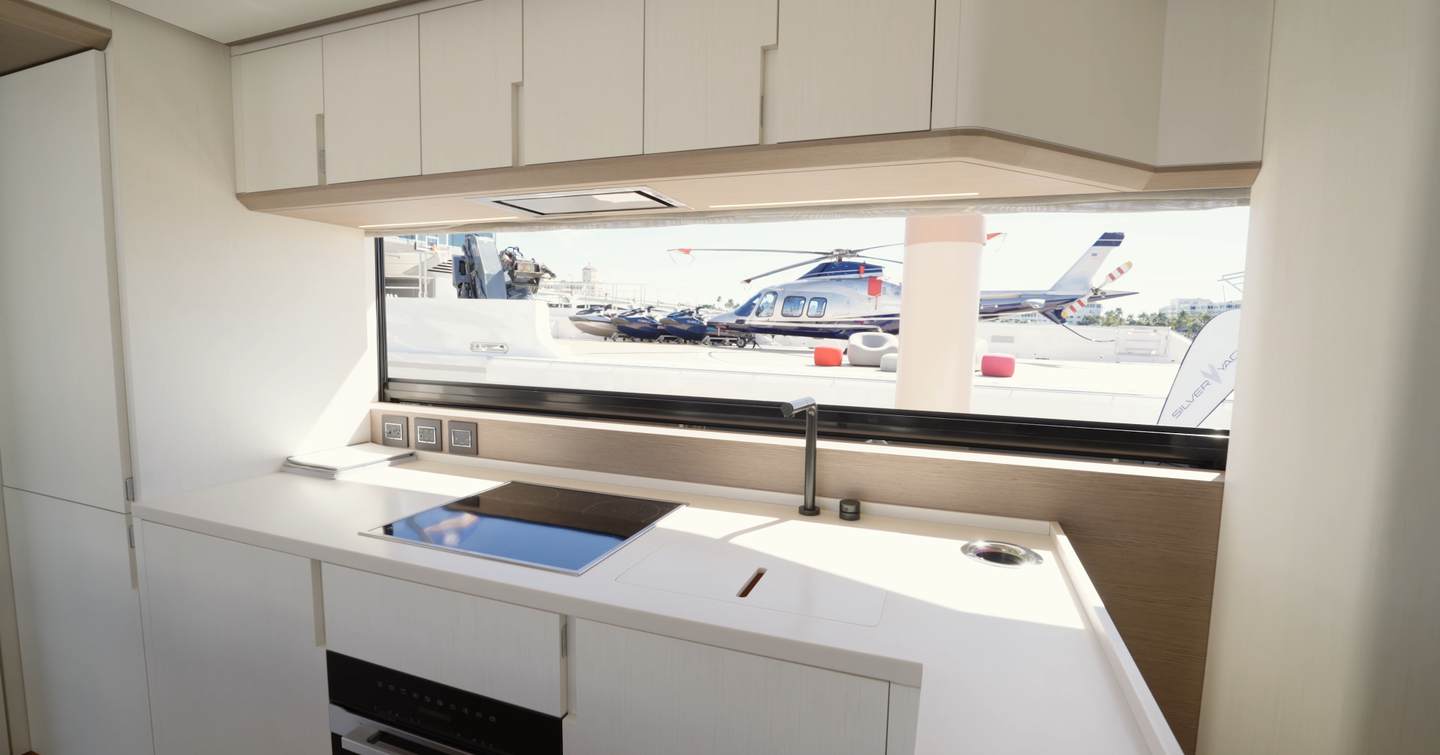
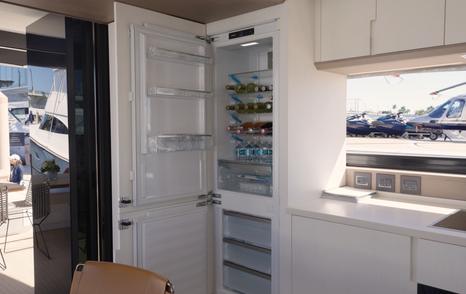

The galley-down arrangement shifts the cooking space to the lower deck, creating what Pardo calls a "country kitchen." It’s a larger, more private galley with domestic-sized appliances, big worktops, and a breakfast bar. This frees up the main deck for a much bigger lounging and dining area - more open-plan, more like a mini superyacht in feel.
It could be a good fit for owners cruising with crew, as it gives the galley a bit of separation from guest areas. In order to fit the lower galley in, Pardo loses the VIP cabin and moves the two otherwise forward twins amidships to neighbour the owner's cabin, and the galley takes their position, behind the separate crew space in the bow.
Which version makes the most sense comes down to how the boat will be used. For relaxed family cruising, the galley-up layout keeps things practical, sociable, and maximises sleeping capacity. For longer trips, liveaboard use, or those regularly running with crew, the galley-down version opens up the saloon and creates a cooking space that feels more in line with larger yachts. Either way, Pardo is not pushing owners into a one-size-fits-all solution. They’ve left room for personal cruising styles to shape the space.
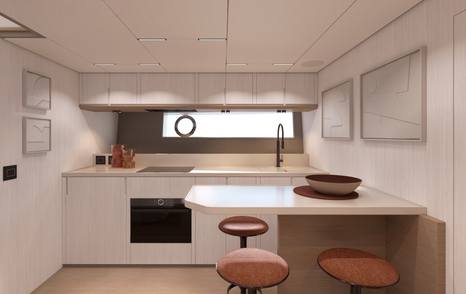
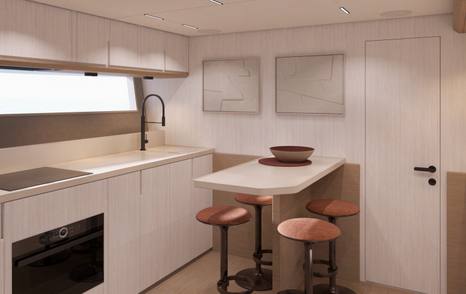
There’s also a key choice on the flybridge. Owners can opt for a soft bimini that gives a wonderfully open feel and can be retracted in seconds - a lightweight, simple solution that suits the boat’s breezy deck spaces. The alternative is the smart louvred carbon T-top. It’s a solid, permanently fitted structure that adds around €150,000 but brings a more substantial look and the ability to control sunlight with its slatted roof. Both options can be extended aft with a powered sunshade.
The choice here will likely come down to cruising habits and aesthetic preferences – bimini for lightness and flexibility, T-top for a little more presence and convenience. Again, it’s one of the ways Pardo gives owners the freedom to set the tone of their own boat.
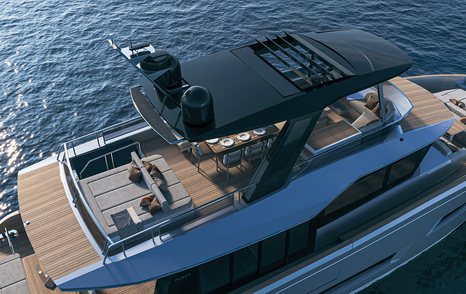
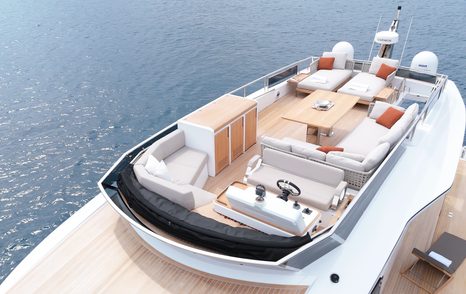
The design also keeps owner operation in sharp focus. The Endurance 72 can be comfortably handled by a couple, mainly due to Volvo’s IPS joystick system, optional Dynamic Positioning, and the availability of a third helm station in the cockpit for close-quarters manoeuvring.
Side decks are broad and safe, the high bulwarks offer good protection, and the side door by the lower helm makes it easy to step out and handle lines when docking. Berthing stern-to in a breeze feels manageable, even without a full crew.
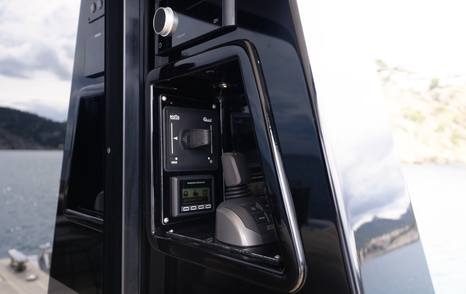
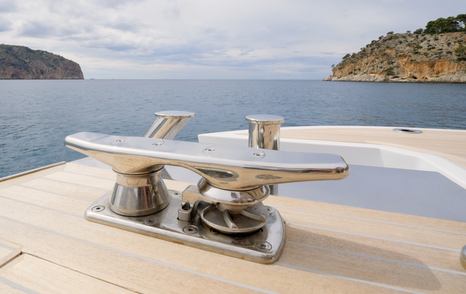
Engine Room
Engine room access is through a cockpit hatch, and while the tender garage arrangement on deck is certainly convenient, this is where you’ll find the trade-off, as headroom in the centre of the engine space is very limited. It’s especially tight around the Quick gyroscopic stabiliser and one of the two generators (the boat has one as standard and a second as an option), where the clearance is squeezed to make space for the tender hull above.
The upside is that the main engines sit outside of this low section, so access around them, particularly outboard, is pretty decent. Headroom improves again towards the aft end of the engine bay, where the pods are.
From an engineering perspective, Pardo’s track record is strong, and that holds here. The installation is pristine: stainless steel fuel tanks fitted with sight gauges, twin fuel filters for easy crossover in case of blockage, and the Glendinning automatic reel system for the shore power cable.
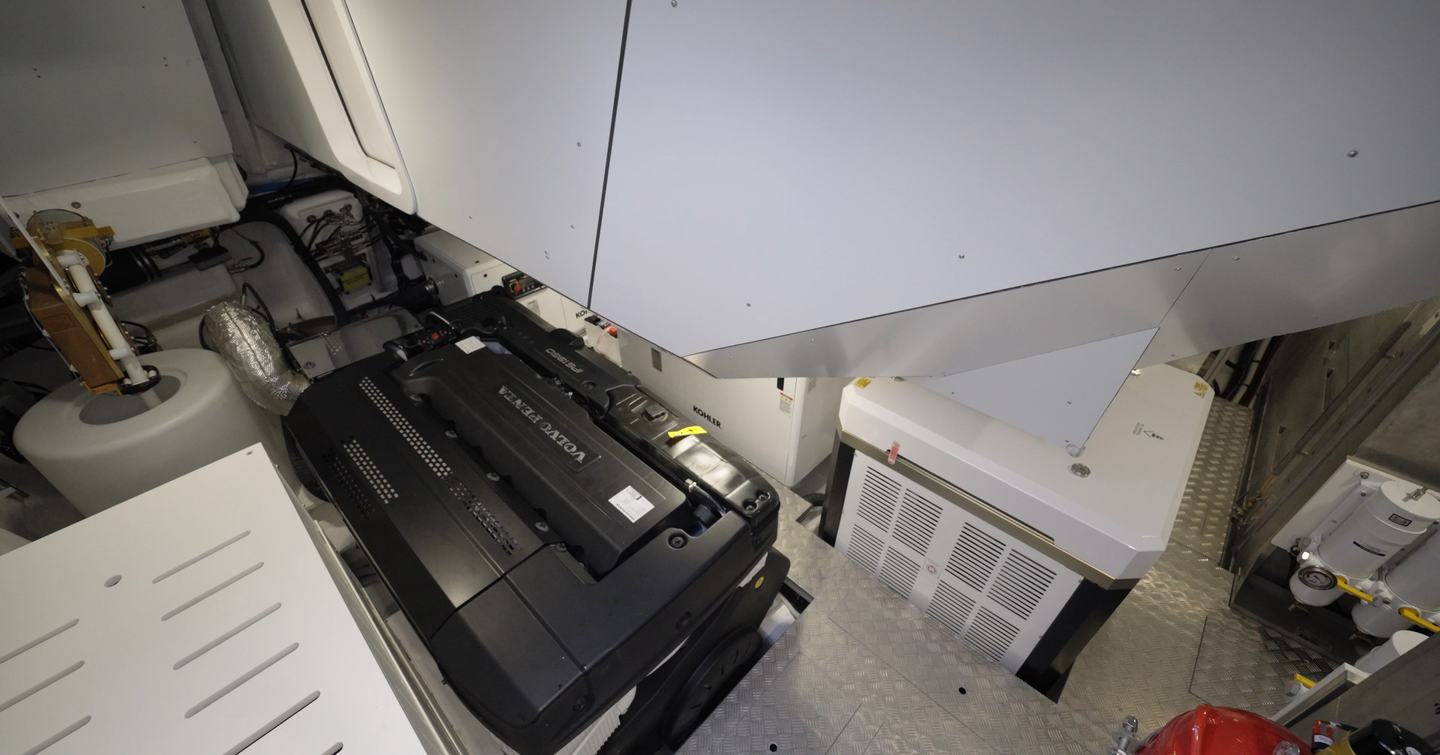

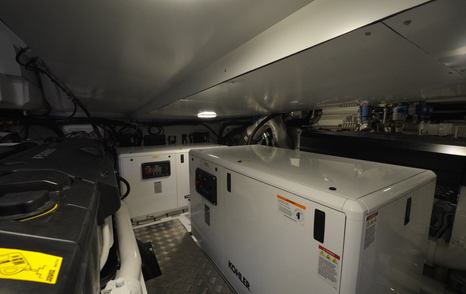
It’s fair to say that on a boat like the Pardo E72, you're unlikely to spend long stints inside watching TV - this is the kind of boat that's not set up for it. Even so, the arrangement does feel a little bit waiting-room-like. The main seating runs along one side in a single line, all quite close together. There is a small bench opposite, but it’s pretty tight and doesn’t offer much in the way of additional seating.
The TV is over on the far side, and it’s a drop-down unit that rises to fill the window space when in use, lining up nicely opposite the larger part of the sofa. Just aft of the saloon, the galley sits by the cockpit doors and the dining table – it’s minimalist, compact but well-equipped.
The indoor dining table does claim a fair bit of floor space, though chances are most people will prefer to eat outside when the weather plays along. Still, it’s a generous table if you do want to eat indoors. Most important though, this whole aft area is so open, via the sliding door to the cockpit, and the aft glazing that slides right across too, softening that inside-outside divide.
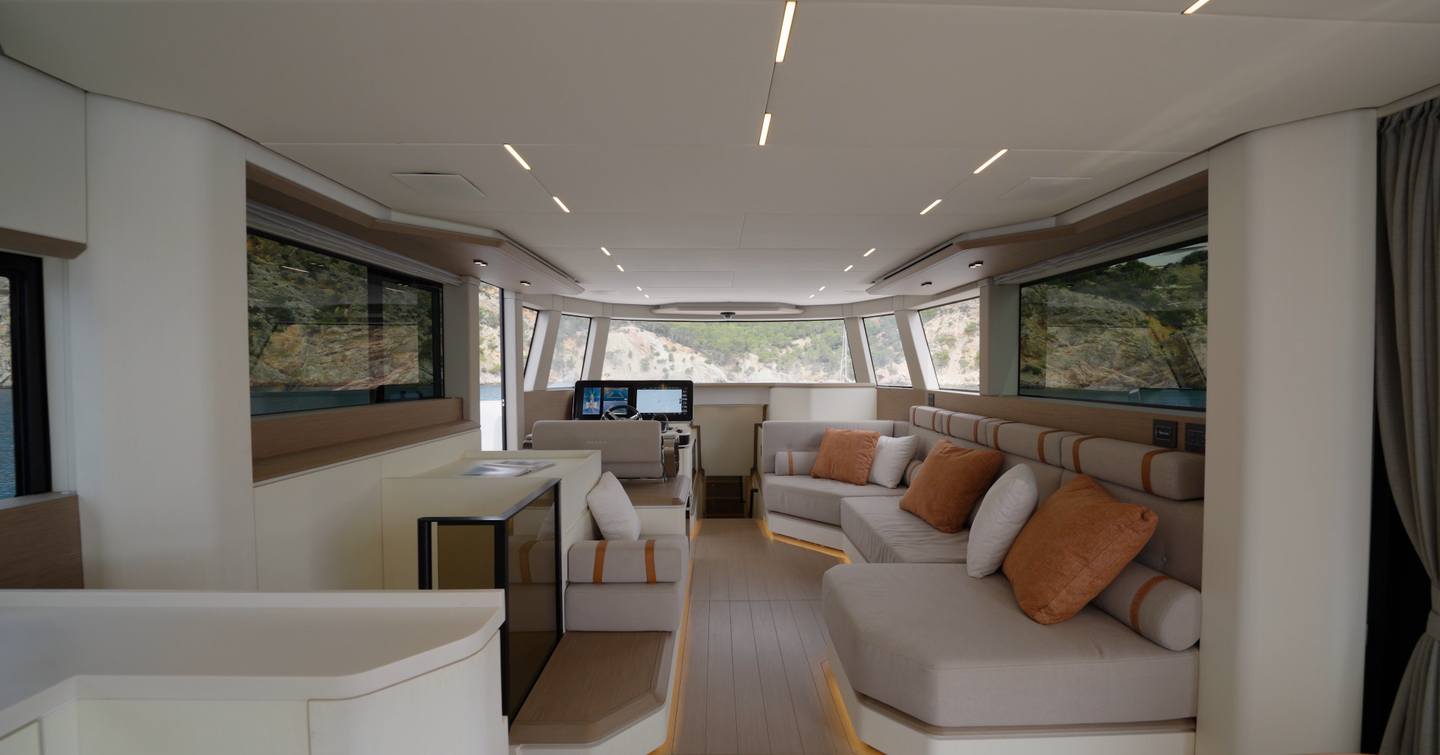
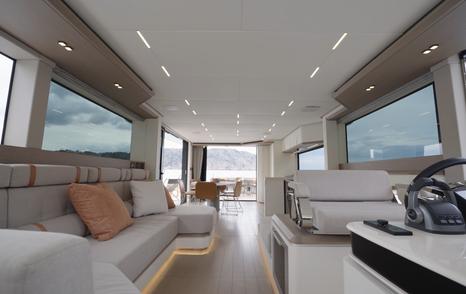
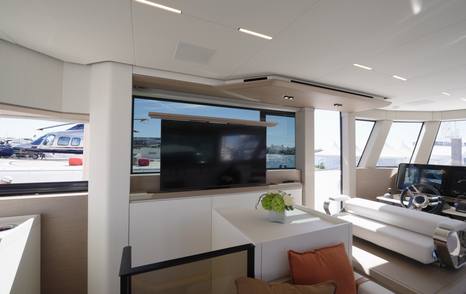
Owner's Cabin
The owner's cabin has a smart bureau creating a natural partition that gives the space its own entrance lobby of sorts. There’s a large mirror as you step in, and most of the hanging storage is grouped to one side, backed up by plenty of drawer space dotted around the room, and you’re not going to run short on storage here. There’s a sofa to starboard, generous bedside tables on both sides of the bed, and repeater switches within arm’s reach to control lighting, air conditioning, and the blinds, without leaving the bed.
The bathroom follows a layout that’s becoming increasingly popular across several brands, but it’s easy to see why. The shower cubicle is set forward, the toilet alongside, and twin sinks stretch out across the vanity to provide plenty of practical surface space. The doors into the ensuite are fully see-through, which is a bit chocolate fire guard.

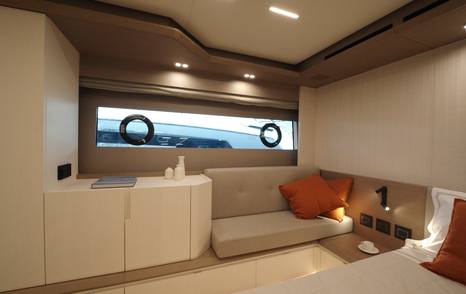
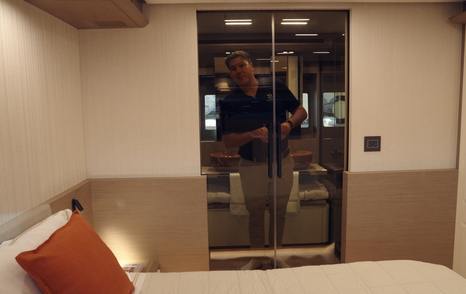
VIP Cabin
The VIP guest cabin's position is quite unusual alongside the owner’s cabin. You don’t often see that arrangement, but privacy still holds up thanks to a good-sized ensuite and a useful little lobby area, much like the owner’s, where there’s extra storage.
You could have guests in the twin cabins forward, while the owner and their children use this space, or give guests this whole section if you prefer. Either way, it works for mixed groups on board. The cabin itself has plenty of headroom, a walk-around bed that’s a good size, a TV fitted in, and its own slice of hull glazing to pull in a bit of light.
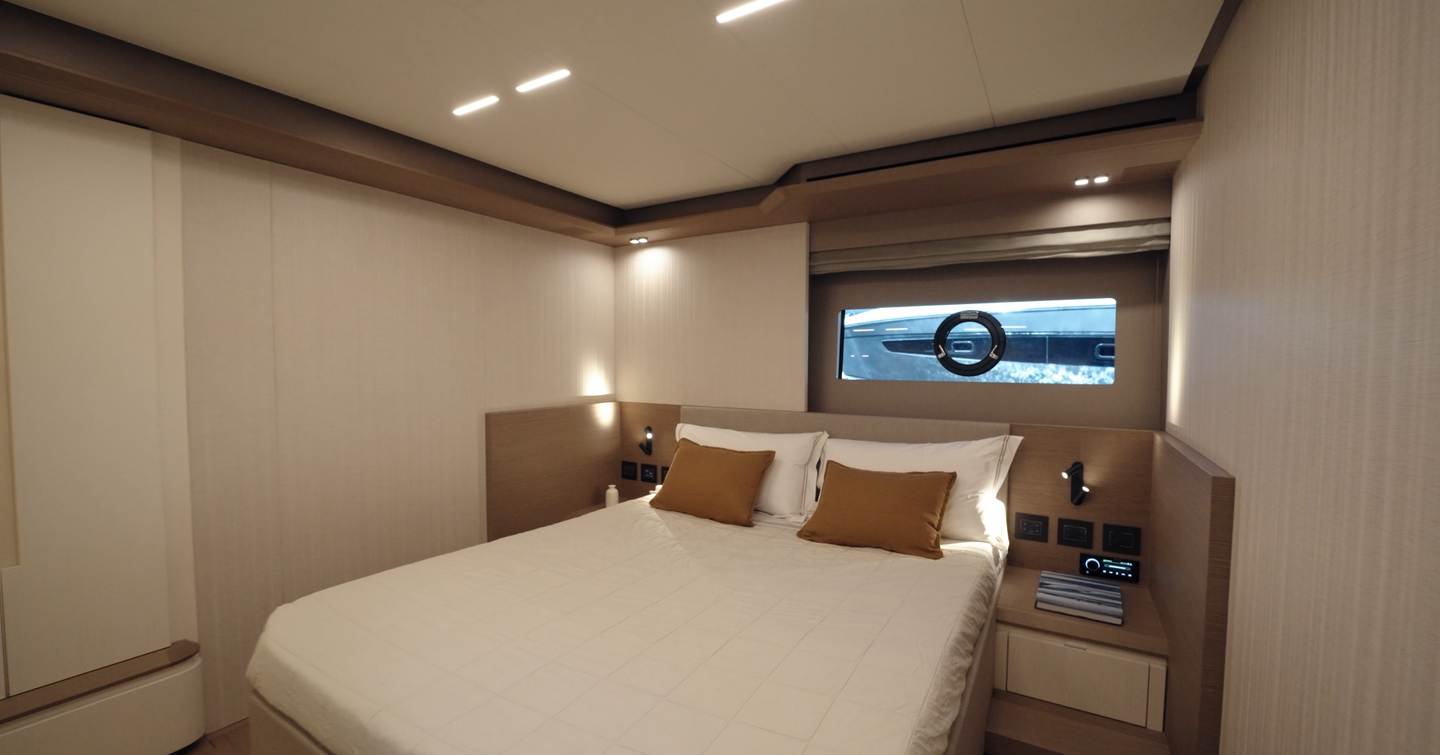
Twin Cabins
Moving forward brings you to the twins, which are identical. They’re good cabins, genuinely usable, with enough width between the berths to move around comfortably. It does pinch in a bit as you pass the beds, but not enough to be a nuisance. Storage holds up well here, too; there’s a decent hanging locker tucked behind the door. The TV’s in a slightly awkward spot as it sticks out more than you’d probably like in a space like this. A smaller screen, maybe behind the door, might have been in a better position.
Both cabins have their own ensuites. They aren't huge, but the privacy is welcome. It’s a little tight through the doorway, but the designers have done a good job fitting in a separate shower cubicle, as it keeps the rest of the space dry. There’s a smart little sink, a porthole for some air, and although compact, it’s a nicely appointed bathroom.
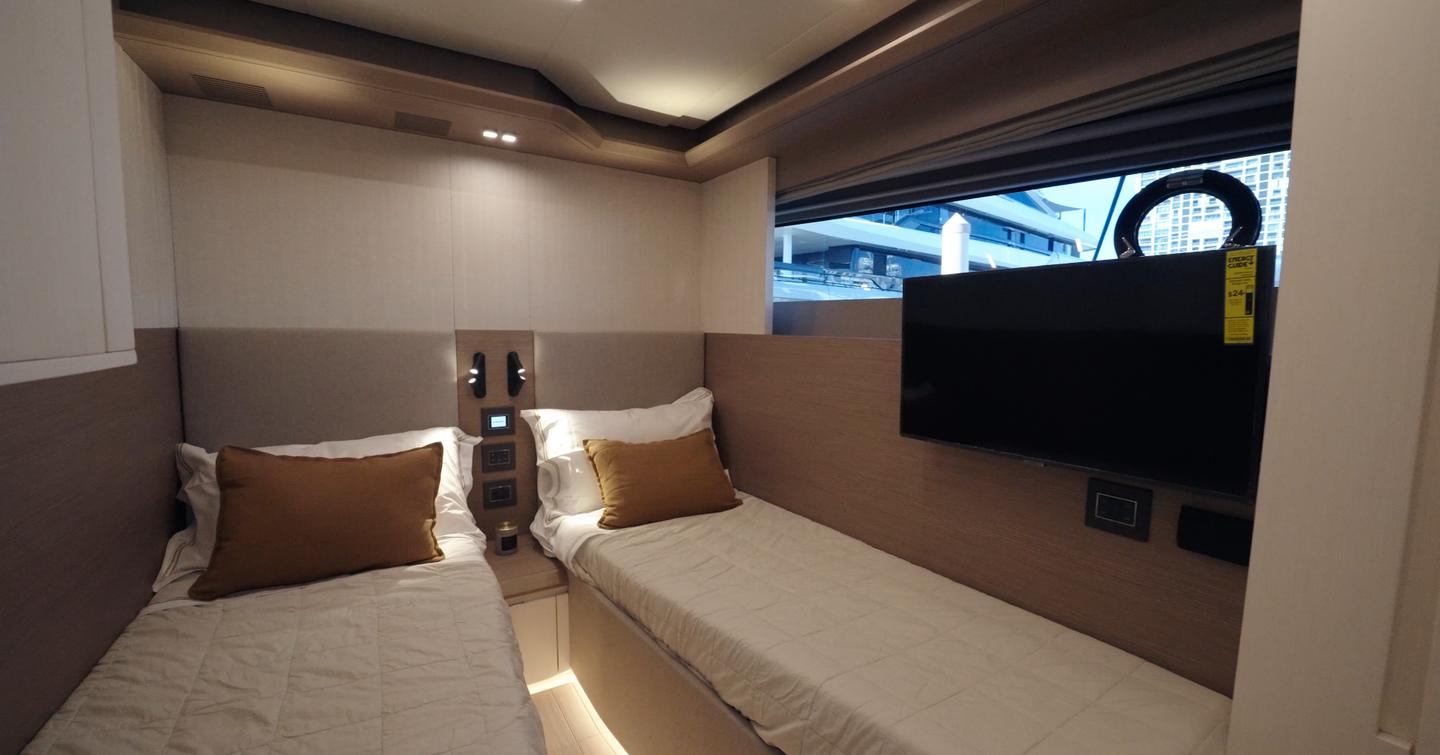
Crew Accommodation
Access to the crew cabin on the Pardo E72 is via a foredeck hatch. This is one of those boats that sits right on the edge of being a fully crewed vessel, as some owners will choose to run with crew, others might prefer to go without.
The crew cabin comes as standard, but for owner-operators, it’s just as useful as occasional guest berths or a very handy storage space. It’s also where you’ll find the washer-dryer, which wouldn't be great for owner-operators, but for crew, it’s perfectly practical and keeps laundry well away from the main accommodation. The crew area has a pair of bunks along one side, with headroom that’s tight once you’re in. There’s a separate bathroom in here, too. That said, if top-tier crew facilities are high on your list, there are competitor models in this size range that offer better, purpose-built crew quarters.
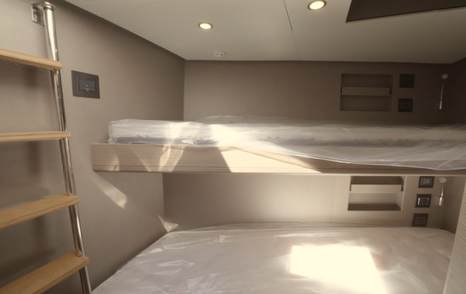
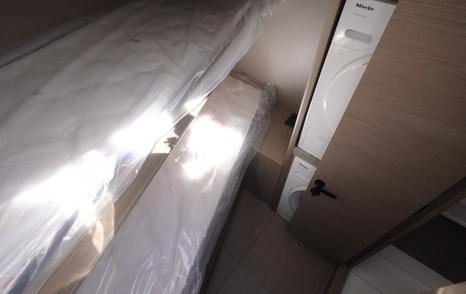
Upper Helm
At the helm, it feels like style has perhaps edged ahead of practicality, something that carries through to the lower helm as well. The bench certainly looks the part, but in practice, it’s not quite there. When the bolster is down, you end up sitting too low and too far back. From that position, you can’t see the bow, and that disconnect doesn’t inspire much confidence. The natural response is to stand up or lean on the bench instead, but with the low-profile windscreen, that leaves you taking the full smack of wind to your face.
Visibility itself is fine from up here, and the bench is wide enough to seat a couple of people, but you’re left feeling just a touch removed from the action. The helm simply doesn’t feel like a place that’s designed to draw the driver in. The layout and ergonomics suggest something else entirely - a boat that encourages you to relax back, hit the autopilot, and take in the scenery rather than be fully engaged at the wheel.
The twin MFDs do present all the key information cleanly, and it’s nicely presented. There are useful details too, cup holders close by, and some shallow storage underneath. But it’s hard to shake the sense that the emphasis is on the visual appeal rather than driver connection. It’s a great-looking helm, no question, but functionality is lacking.
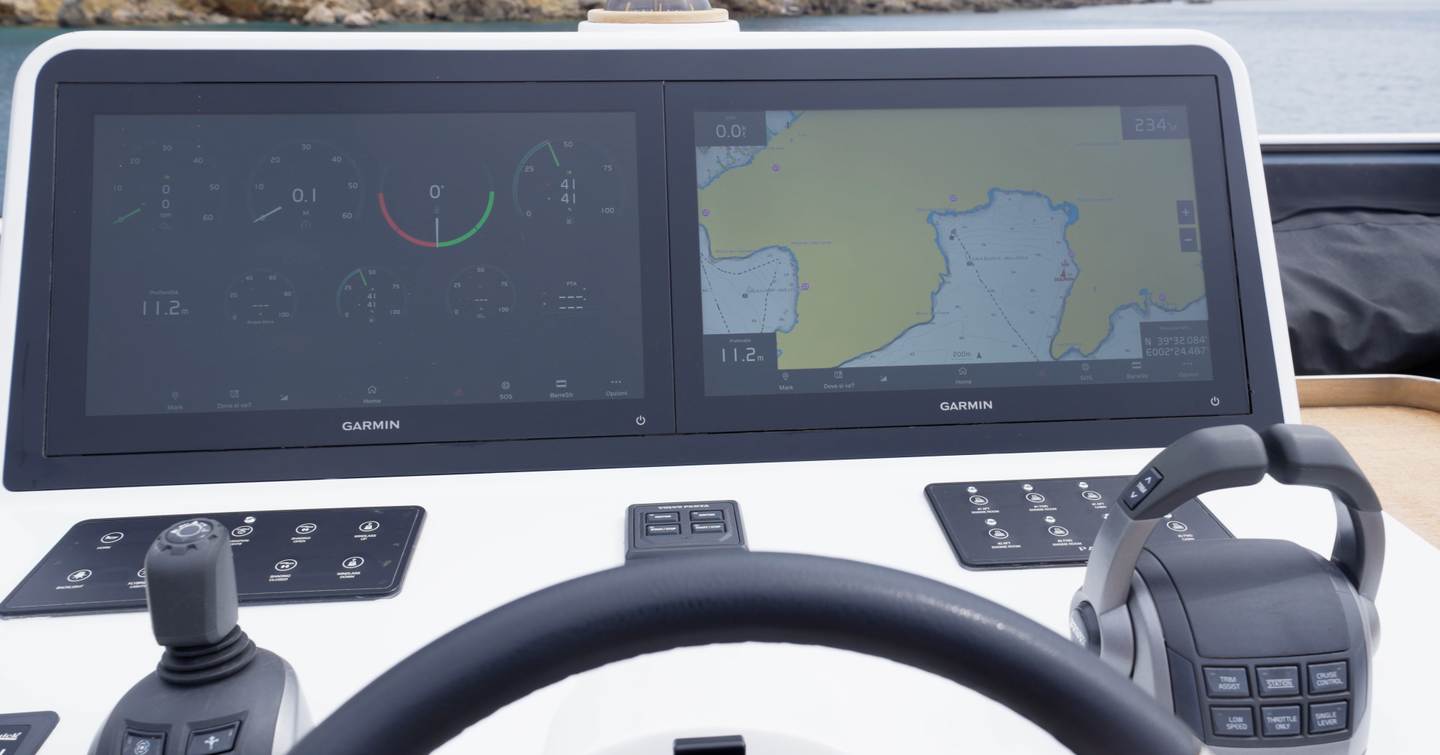
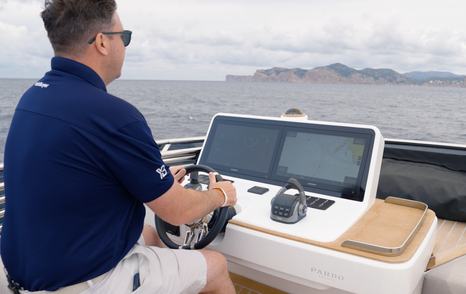

Lower Helm
Downstairs, the main helm is quite similar to upstairs. There's a slightly narrower version of the upper bench seat, and it carries over the same problems. It encourages you to sit back and settle in, but you can bolster it too, which makes a nice leaning perch. That bit of extra height gives you a clearer forward view and a commanding line of sight across the dashboard, and you are less exposed.

Big, upright MFD screens sit right in your eyeline, so there’s no squinting or craning to see the important stuff. There’s also a smaller Volvo Penta display on the lower dash to keep engine data visible at all times, particularly if you’re running radar or charts across the top screens.
It’s a nicely presented helm and everything is get-at-able: throttles to one side, joystick the other. You’ve got multiple berthing stations to choose from on this boat, and with IPS-only engine options, joystick control is always part of the package.
This particular boat is fitted with the largest IPS1350s at 1,000hp a side. You can spec smaller units, but honestly, this feels like the right choice. It comfortably supports the mid-20 knot cruising band, and for this size and style of boat, the larger engines just make sense. It’s also a practical tick when you think about resale, as buyers will gravitate towards the higher engine spec on the second-hand market.
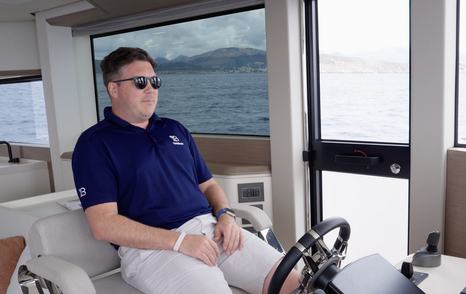
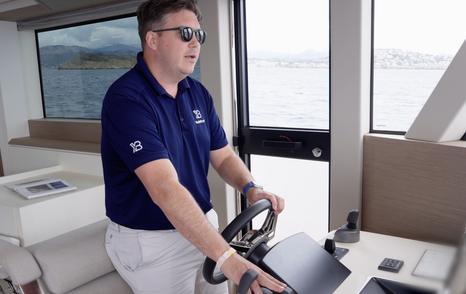
The view from the lower helm is good. There are mullions, of course, but Pardo has split them, so they’re not chunky enough to create actual blind spots. Plus, there’s a small opening window at the helm that improves sightlines further. You’re surrounded by glass, so the connection to what’s happening outside is constant, and you’re in touch with whoever’s in the saloon.
There’s a starboard-side seating area where you could fit a couple of people while the rest of the crew can settle into the seating opposite. Realistically, though, this is the only place down here where you can comfortably sit and look forward. In good weather, the action’s going to shift upstairs to the flybridge anyway, as that’s where you’ll want to be.
Even with the aft door open, sound levels are well controlled. At 21 knots, it’s making easy work of the light swell, with a very relaxed, settled ride. It’s not built for chasing high speeds; you ease into this boat, let it cruise steadily, and enjoy the pace. It feels right on the edge of being a crewed boat, but its handling and control systems are so manageable that an experienced owner could run it themselves. That flexibility rounds out the appeal.


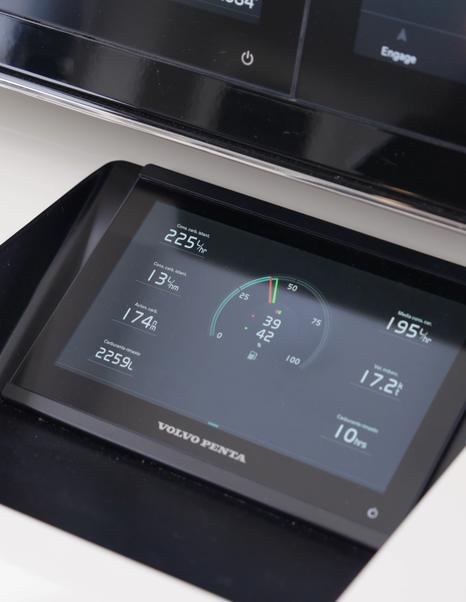
At the stern, the Pardo E72 serves up both a hydraulic platform and a tender garage. The tender can be completely cleared away, leaving the platform clear for swimming/water sports, and it drops nice and low into the water, too.
Access up into the cockpit is balanced on both sides. The winches are built into the cleats, so there isn't a need for separate bollards. You can tension straight off the cleat and tie off cleanly, perhaps a bit belt and braces, but tidier. They’ve also thought about line storage. Small lockers built into the deck have openings so you can lead lines directly down into them with no loose ropes trailing about the place. The drop-down balconies are a cost option, but they’re wide and long enough to almost double the beam at deck level.
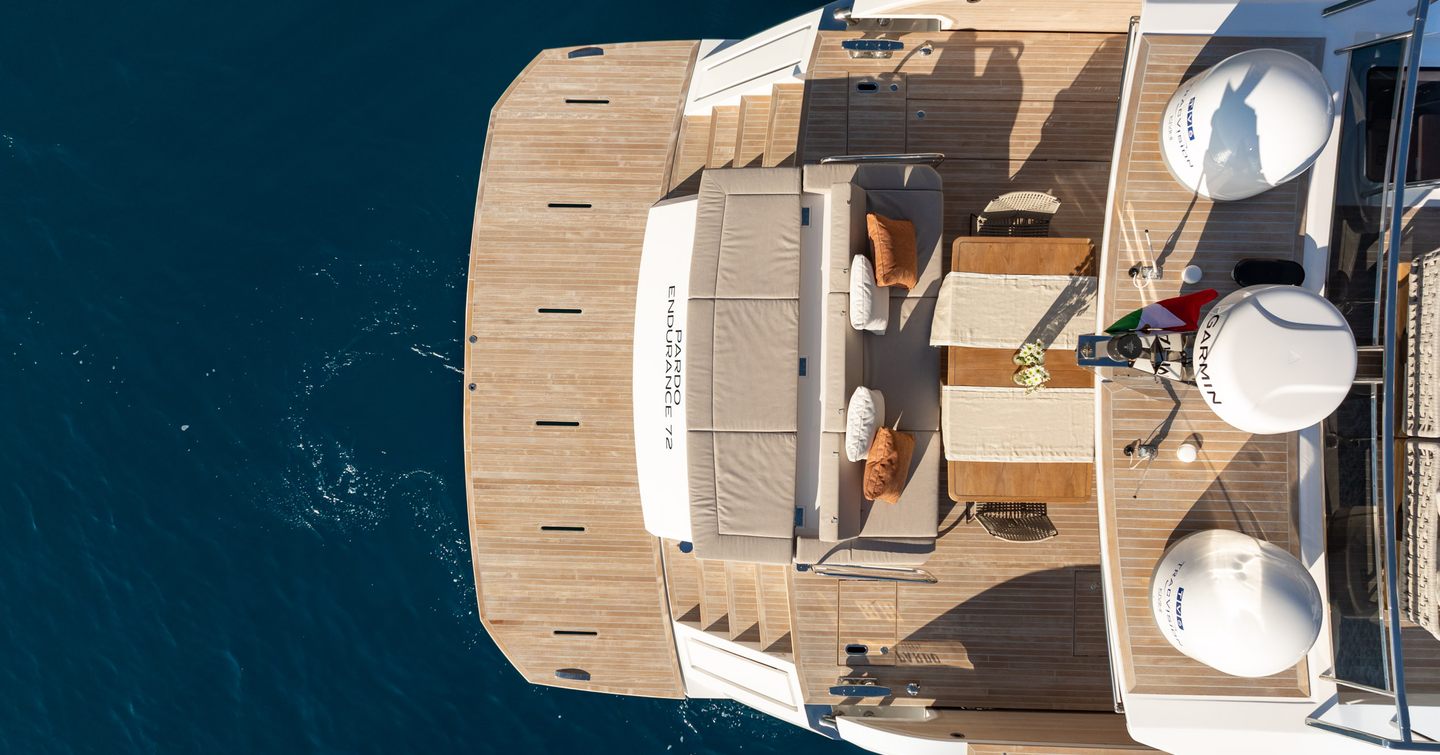

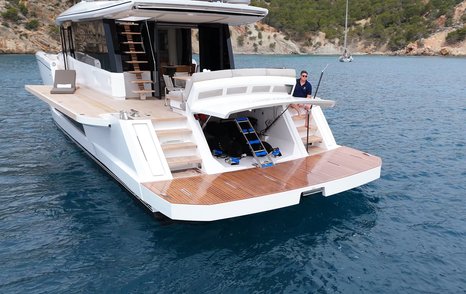
In the cockpit, the fixed overhang isn’t especially long, but the extendable canopy reaches out, shading the sun pad. The sun pad itself is something we’ve seen on Pardos before. Each of the three backrests is on a ratchet, so you can adjust them individually for lounging/dining and then drop them flat again to return them to a full sunpad. There’s a set of drawer fridges tucked under the seating on both sides - useful, even if the galley is a few steps away, to have cold drinks immediately to hand.
There’s also an optional third joystick station in the cockpit. Along with the joystick itself, there’s a repeater for the thruster, so if you’re mooring stern-to, you’re perfectly placed to handle it from here with clear sightlines. It’s a well-thought-out driving environment, and the way the spaces connect is particularly good.
The flow is quite like the Azimut Seadeck 7 - there’s an aft door, a side door, and an option to add a drop-down galley window, all working together to open up the cockpit and the main deck. On a breezy morning, you’d hardly need the air conditioning. The natural airflow through the open doors, including a third starboard door and windows, does the job very well.

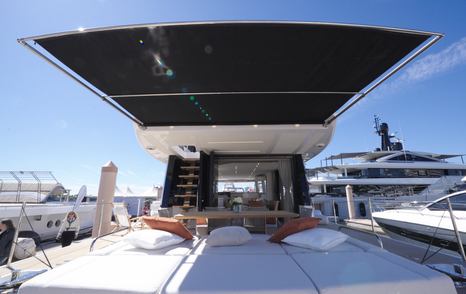
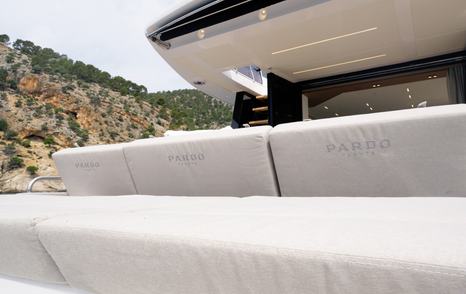
Side Decks & Foredeck
In true Pardo fashion, there are no guardrails along the deck, but it does have tall topsides giving you protection as you move about. It feels safe and solid underfoot, even without the rails. The big, chunky pop-up cleats are a lovely detail and easy to get hold of. With no railings, though, you lose the usual spots to hang fenders. Instead, Pardo has fitted dedicated sockets. They have their pros and cons - great for quick deployment and removal, but fixed in position, so you can’t shift them to suit different docking setups. It’s a compromise that comes with the clean, open look.
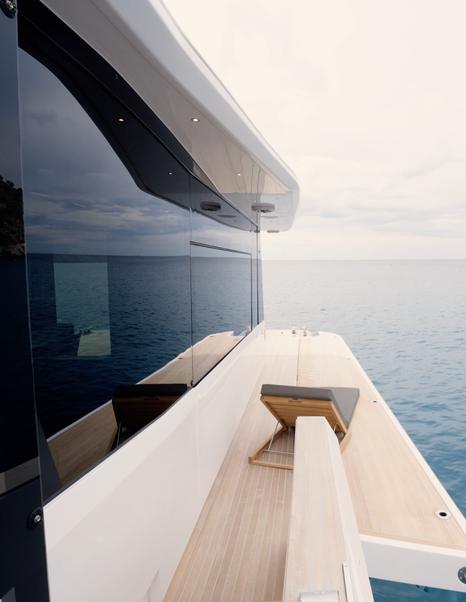
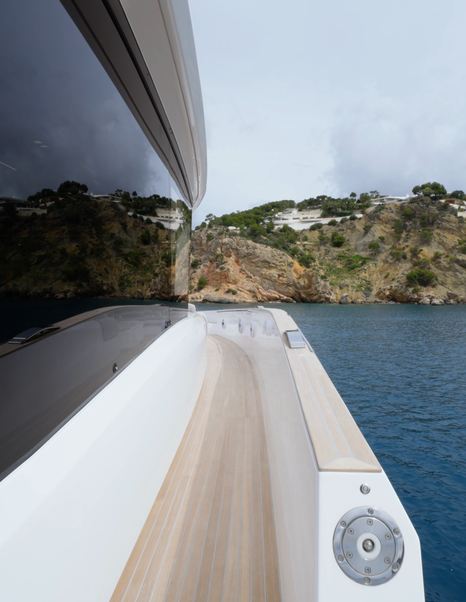
On the foredeck, Pardo has created an inviting lounging area. The deck here is completely flat, which makes it safe to move around in bare feet. There’s a smart arrangement of opposing sofas with fridges close by for cold drinks and plenty of cup holders and cubbies for the usual bits and bobs. There’s no table as standard table, however. Further forward and you’ll find more sunbathing space, and a nice bench right at the bow.
You’ll find another set of big cleats, with the winches neatly recessed and decent-sized fairleads built in. The anchor is fully hidden, keeping the foredeck clear, and the access sits just under one of the forward cushions.
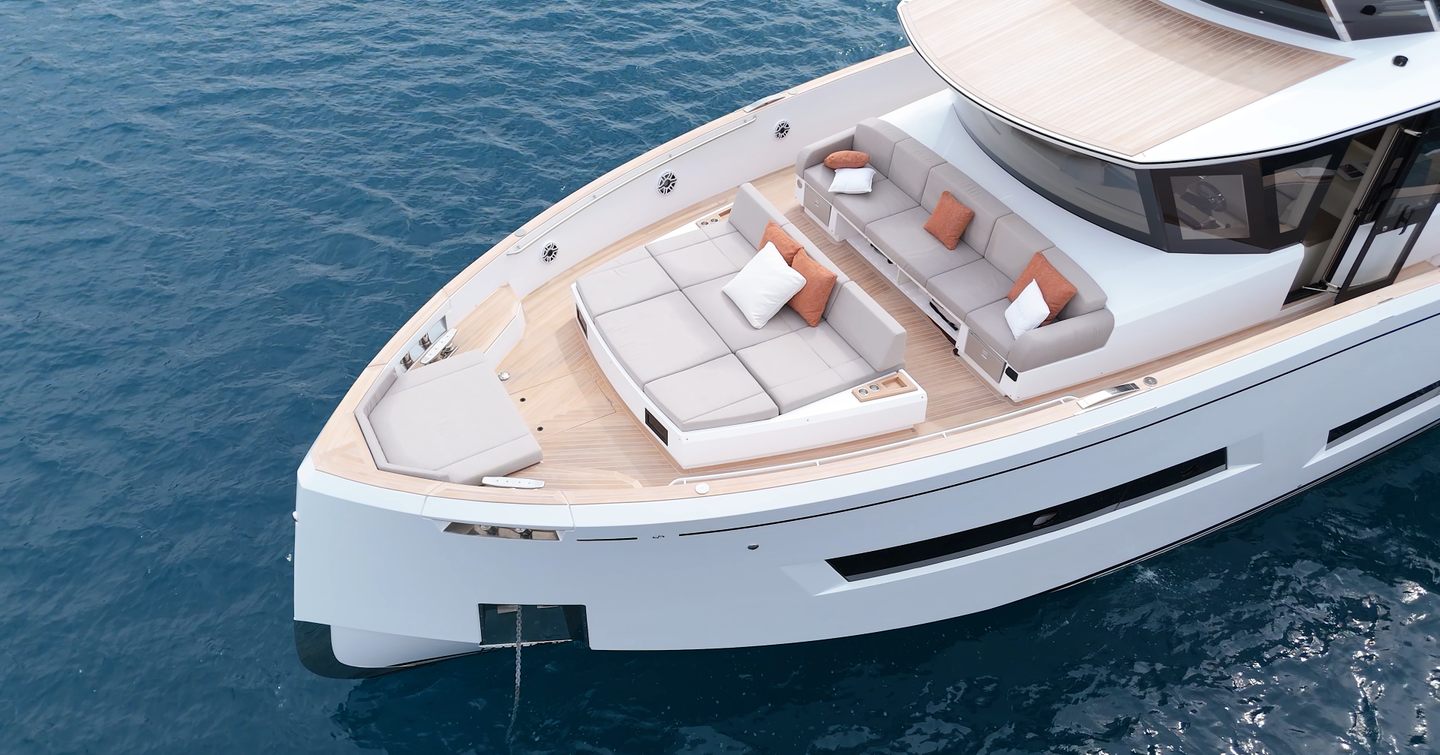
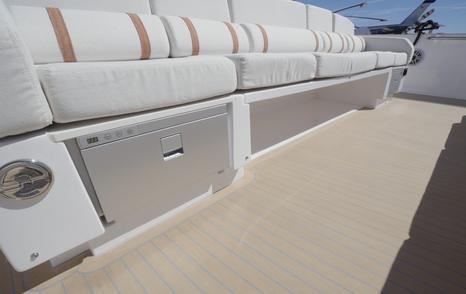
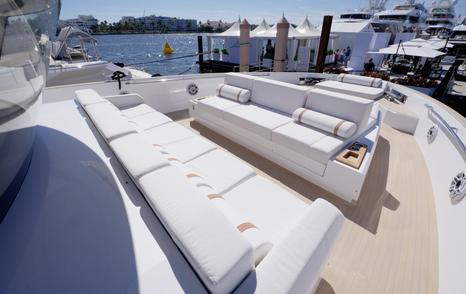
Flybridge
The flybridge is where the E72 pulls clear of the smaller models in the range. It’s larger than what you’ll find on the Seadeck 7 and comfortably on par with the size offered by the Navetta 70s. It’s a seriously stylish space, though worth noting that several key elements up here sit on the options list - and those options don’t come cheap.
The sunbathing area, for instance, is a cost option, but it’s so lovely that most owners will probably want to tick that box. It’s broad, well-shaped, with pop-up backrests, and nice details like a timber panel in between the cushions, plus shallow cup holders. Overhead, there’s a retractable shade that pulls out a long way, similar to the shelter options on the main deck.
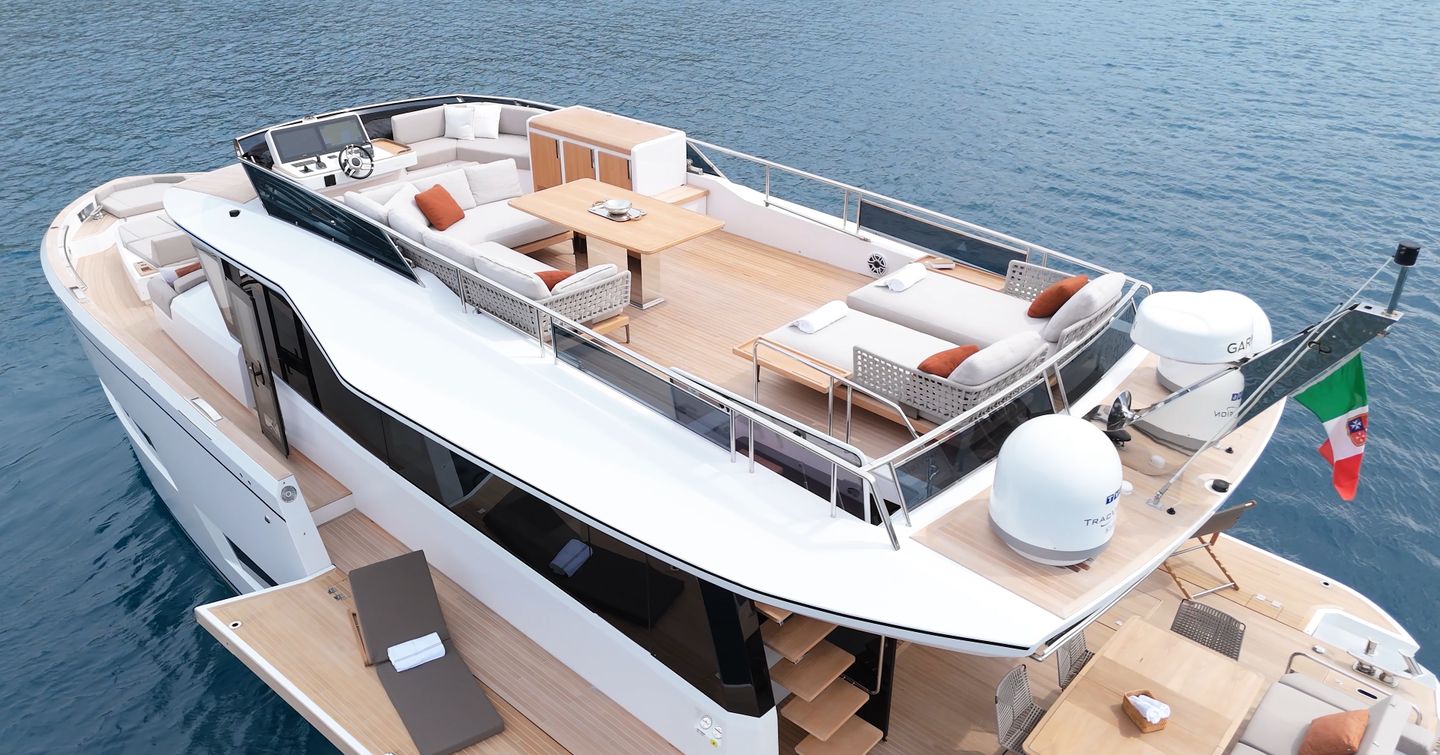
The T-top is another big-ticket item - around €170,000. You can save yourself roughly €150,000 by opting for the Bimini instead, but in warmer places, the convenience and flexibility of the T-top will likely win out. It’s fitted with a slatted sunroof - not as open as a canvas setup, but it still gives a useful degree of overhead control. The dining area works well up here too, with a good-sized table and enough space to bring up a couple of extra chairs on the open side if you want to.
The wet bar has a pair of champagne coolers integrated into the step below, and the bar itself is beautifully finished with a teak countertop and fascias. You’ve got a big sink, an induction grill, and a sliding chopping board. Behind the bar, the storage, fridge, and ice maker are exactly where you’d want them. It’s a proper cooking and serving space, and nothing like this is available on the deck below.
Just next to the helm, there’s a little seating area, though some might not love sitting sideways while the boat’s moving. But when you’re at anchor or docked, this arrangement comes into its own.
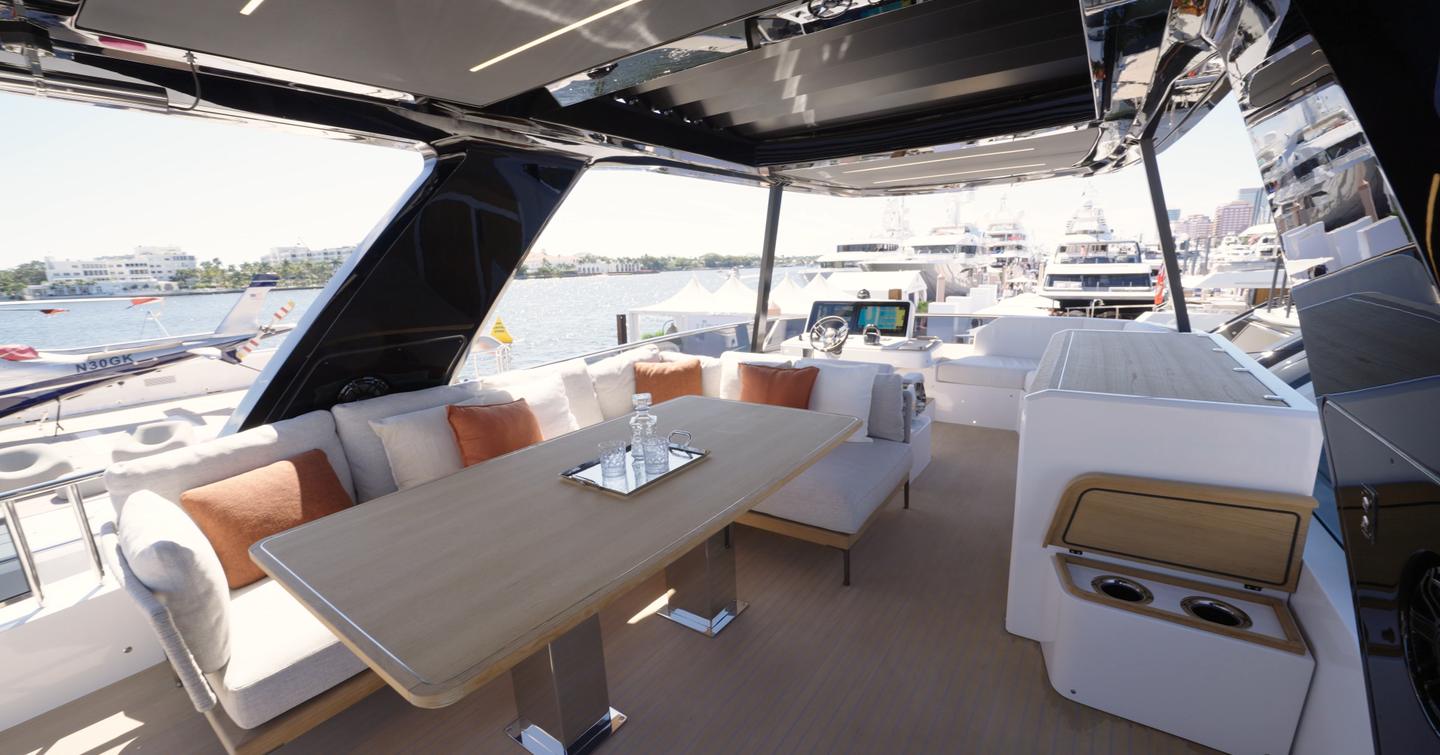
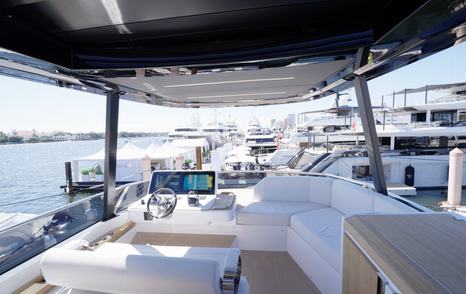

€3,700,000 ex VAT is the starting price for the E72. But for a boat with the bigger Volvo Penta IPS1350 engines and most of the key options, you'll be looking at around €4,900,000 excluding VAT (correct at time of writing).
Our Options & Pick
There is a big discrepancy between the base price and a realistic on-water price, and that's partly down to the fact that the E72 has some particularly expensive cost options. Some of the key items we'd tick the boxes for would include: IPS1350 upgrade (€132,000), gyro stabiliser (€160,000), Volvo DPS (€27,800), Volvo Interceptor blades (€40,900), teak decking (€23,500), teak on the flybridge (€39,900), flybridge dining option with wet bar, chairs and sofa (€25,900), hydraulic passerelle (€35,500), hydraulic bathing platform (€52,500), tender launch system (€22,500), flybridge bimini (€28,500), cockpit terraces (€79,900), tropical air-con (€18,500), 22in MDF pack (€26,000).
Those are the major options we would choose, but it's not exhaustive, and much will come down to personal preference. Options costs on large motorboats have gotten out of hand across the board, but some of these do seem particularly steep, such as €40,000 for teak on the flybridge and €150,000 for a T-top.
Our Verdict
If two themes stand out in yacht design right now, they are 1) expanding deck space (particularly with fold-down balconies in the cockpit) and 2) covering greater distances at cruising speeds. The Pardo Endurance 72 does both of these trends beautifully. The way the main deck opens up at anchor is spectacular - it transforms the stern. Lots of brands in this sector offer their spin on these flexible deck arrangements, but Pardo seems to have pitched it spot on. The layout just works.
Of course, there are some compromises. The guest cabins are on the smaller side compared to some rivals at this length, the crew space is pretty tight, and the saloon feels a touch narrow. But if what you’re after is a yacht that can eat up the miles comfortably, with the sort of long-range usability you could live on board - and you want to do it all wrapped in unmistakable Italian style - the E72 is the one.
Reasons to Buy
- Amazing main deck
- Build quality
- Tender garage
- Four ensuite cabins
- Efficient cruising
Things to Consider
- Small crew cabin
- Sub 30-knot top speed
- Narrow saloon
Looking to own a Pardo E72? Use YachtBuyer’s Market Watch to compare all new and used Pardo E72 Yachts for sale worldwide. You can also order a new Pardo E72, customized to your exact specifications, with options for engine choice and layout configuration. Alternatively, explore our global listings of new and used yachts for sale and find your perfect yacht today!
Rivals to Consider
Which has better accommodation, the Pardo E72 or the Arcadia Sherpa 80? Both yachts comfortably host up to eight guests, but they approach guest spaces differently. The Pardo E72 treats its guests to a spacious, full-beam master suite, complete with generous hull-side windows and private ensuites for every cabin, delivering a luxurious and private feel. The Arcadia Sherpa 80, meanwhile, provides flexible layouts accommodating either six or eight guests, alongside clever eco-friendly touches like its extensive solar panels generating around 2.5 kW of energy, reducing generator use and enhancing quietness on board.
How does the Pardo E72 compare to the Extra Yachts X76 Loft for onboard comfort? Both yachts cater comfortably for eight guests, but their onboard atmospheres are quite distinct. The Pardo E72 focuses on privacy and elegance, particularly with its generous full-beam master suite and dedicated en-suite bathrooms throughout. On the other hand, the Extra X76 Loft excels at creating welcoming, open-plan social areas. For those who appreciate quiet luxury, the E72 is ideal, while the X76 Loft is superb if open, relaxed entertaining is more your style.
Is the Bluegame BGX73 or the Pardo E72 better suited to family trips? The Bluegame BGX73 offers a cosier feel, accommodating six guests across three cabins. These yachts are thoughtfully laid out for smaller families or couples. Conversely, the Pardo E72’s four-cabin arrangement comfortably carries up to eight guests, offering flexibility for larger families or those who frequently invite guests aboard. If your trips usually involve smaller, close-knit groups, the Bluegame may have the edge, while the E72 suits those who like a bit more flexibility.
Pardo E72 vs Pardo GT75: Which has a better cruising speed? When it comes to speed, the two Pardos cater to very different cruising styles. The E72 is happiest cruising comfortably around 18–20 knots, with a maximum speed of 26 knots - perfect if leisurely passages and smooth, stable rides appeal to you. The GT75, in contrast, delivers noticeably more spirited performance, comfortably cruising at around 30 knots and able to reach a brisk 38 knots, thanks to its triple 701hp Volvo Penta IPS setup. For relaxed, comfortable cruising, choose the E72; if speed and lively handling matter more, the GT75 is the yacht for you.
Should you pick the wallywhy150 or Pardo E72 if space is your priority? If maximising onboard space tops your wish list, the Wally WHY150, with its generous 150 GT interior, is in a league of its own, providing expansive spaces rarely seen in yachts of this size. However, the more compact dimensions of the E72 mean easier handling, docking, and a more intimate onboard atmosphere.
Considering a new yacht? Explore Pardo's entire current range to find the model that best suits your needs, and compare it with alternatives from competitors to ensure you make the perfect choice.
Specifications
- Builder Pardo Yachts
- Range Endurance
- Model E72
- Length Overall 72' 2"
- Beam 18' 7"
- Draft(full load) 5'
- Hull GRP
- Cabins 4
- Berths 8
- Crew 2
- Cruising Speed
- Max Speed
- Fuel Capacity 1,585 Gallons
- Fresh Water Capacity 317 Gallons
- Engine Model 2x Volvo Penta D13-IPS1350
- Engine max range (speed type) 900 (nm)
Interested in a E72?
NEW Build
Find your local dealer for a personalised, no-cost consultation
or just request
Brochures & Pricing
Used & In Stock
Looking for a ready-to-go E72 or pre-owned options? Explore all inventory of the E72 available worldwide
